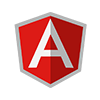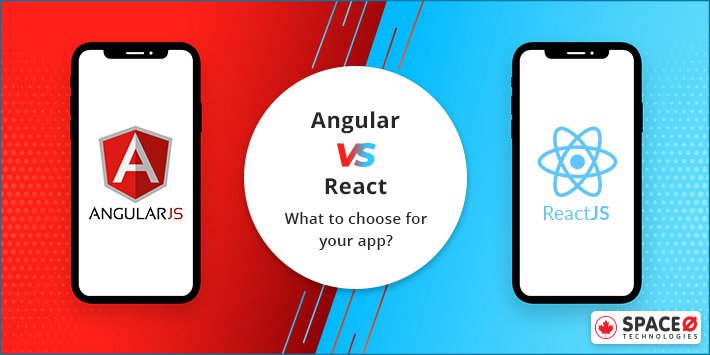You’re here which means, Angular vs React is your next battle and these two have topped up the list of your Javascript frameworks for app development. This also means these two are already the best in the world and different from all. Great. Your half work is done and dusted.
Now, the question is what makes these two different from each other?
No doubt both Angular and React are creative, well-supported methods that are useful for front-end applications out of a huge array of Js frameworks, with constantly newer versions coming in.
However, selecting between Angular and React is a source of debate and it has been going on for more than 7 years. Yet, most of the time, front developers find a hard time choosing the best framework, especially when it comes to a single page application (SPA). So let’s prolong this debate ahead and analyze in this article guide which can be better in what situation. Ready? Scroll down.
Table of Contents
Before we get into details of React and Angular, you might want to know if we could work around without java-script frameworks, so to put in simple words, yes, you can work around without it. You can perfectly code without them with the help of application code editors.
But do you have so much time for it?
Because a well-chosen framework will make your work and decision a lot easier. Not only that, but they also are free and open-source, so there’s no risk in trying as history proves. Also, javascript works on both – client and server sides. It helps design an enriched user experience with a variety of features to modify application pages in real-time.
Owing to the combination of their interoperability and flexibility Js frameworks are favored over other programming languages. The JS libraries offer good scalability, a better functional solution, and platform independence. Out of all frameworks, Angular and React are to be known as the most powerful and popular for your dream app ideas.
So let’s understand what exactly React and Angular stand for.
What is Angular?
Angular is a web application development framework that allows you to create dynamic and robust single-page applications and progressive web apps.
How Does Angular Work?
The Angular framework first reads the Hypertext Markup Language (HTML) file which is loaded with additional custom HTML elements, allowing to import CSS files. Then, Angular interprets such attributes as instructions for linking portions of the page input or output to a specification defined by regular JavaScript variables.
In simple terms, as a template language, Google Angular functions in the task of providing instructions, reducers, browser extension, HTML extensions, and enabling a range of components to be created and reused in programs. It also provides a router that automatically detects errors, risks, and typos.
What is React?
React is an open-source JavaScript library that allows developers to build user interfaces single page applications and mobile applications for cross-platforms.
The React framework is the option for a JSX developer community with its superset typescript to create a high-traffic and interactive web app for different purposes. It is considered the fast-growing Javascript platform, with more than 1000 Gitlab contributors and searches.
The prime users of React are Uber, Netflix, Paypal, Airbnb, Adobe, Autodesk, Apple, The New York Times, Grammarly, HBO, Yahoo, Whatsapp, Twitter, Telegram, and Dropbox.
How Does ReactJS Work?
ReactJS is the platform that simply functions as a view – indicating that the elements of framework React alter and update what the user sees. The React component handles the job of bringing the HTML within the website to show the user data flow to the UI.
However, React idea is mainly concerned with rendering property data to the virtual DOM (Document Object Model), so creating React Software usually requires utilizing external libraries to manage and route (React Router). That’s what only it holds everyone back as a downside.
Statistics: If you believe the ranking data, in the comparison between ReactJS vs Angular, React has more significant downloads than anything and is the most common choice among all frameworks holding 99 Github score.
Does it mean, React is also suitable for your needs and landscape? Not necessarily.
React and Angular, both are empowered in different areas along with popularity, growth, and user interaction. Follow this comparative study of parameters to learn about the most common JavaScript and what they each have to bring for you.
Comparative Study: Angular vs ReactJS
Attribute |

Angular |

React Js |
|---|---|---|
| Release Year | 2010 | 2010 |
| Developer | ||
| Type | Framework | Library |
| Programming Language | Typescript | Javascript |
| DOM Performance | Real DOM | Virtual DOM |
| Architecture | Component-based | Component-based |
| State Management | NgRx, RxJS | MobX |
| App Framework Structure | MVC framework (Model, Controller, View) | No limitation |
| Data-binding | Two-way | One-way |
| Development Speed | High | Medium |
| Popularity | 1100 Github contributors | 1400 Github contributors |
| Documentation | Slow | Slow to Medium |
| Learning Curve | High | Low |
| Testing | Single tool, less efforts | Multiple tools, more efforts |
A Detailed Comparison of Angular and React
-
Performance
-
Expectation: Any performance of front end development frameworks of web applications completely depends on how HTML is modified – that simply means the more effective modification done on DOM, the greater will be material UI development experience.
Now, Angular and React have two different approaches for HTML performance scenarios.
Angular framework concepts make changes directly in the head of the browser’s DOM – that means it operates on real DOM. For instance, if you want to change the location of the profile user, Angular will modify the entire tree structure of HTML, instead of updating just the needed data requests. Now, this process performance may not be convenient for users with old computers and slow devices.
Why?
Updating entire data takes up loads of CPU lifecycles and eventually ends up slowing down mobile applications no matter what your app size and abstractions are. Not only that, but it also slows down even if people have so many connections between the code concept pieces, which forces to consume so much memory on the computer.
React, on the other place, works on the virtual DOM and fiber – that means you can make data changes for the needed data without modifying the entire HTML document. Now, this is the biggest advantage – the front end developers of React have optimized the one-page framework (Single page application) design and looks that enables them to deliver a low load on any computer.
But, how does the React community allow to modify just the needed data without altering all performance?
React has opted for the significant change – they have transferred a load of computations from clients to servers which are virtual DOM and fiber. That means react upgrades a bit more easily, is cost-effective, and guarantees great mobile apps performance in the context of data overview – irrespective of the scale of the devices and Angular apps lacks behind in this approach.
So clearly, React wins due to the scenarios of ease to use in the comparison of angular vs react performance.
-
Speed
-
Expectation: The number of libraries that are readily available to the software developers is the matter of decision factors at what speed the SPA would be developed. That means having a bit more necessary libraries in sizes at hand will improve the ongoing development process of the web application. So the more libraries are available, the faster the mobile app development.
Now, let’s see how React and Angular fulfill your expectations in this regard.
Angular provides improved functional programming experience as its command-line interface (CLI) enables users to easily build a workspace and construct working web apps, and to design components and facilities with one-line orders, streamlined processes to solve detailed problems, and TypeScript’s clean basis coding functionality.
So you only need to install a javascript library according to your requirements and compatibility and start operating immediately – that is how simple it is – one of the greatest advantages of Angular over React.
React, when it comes to mobile development speeds, it gets affected because there’s third-party libraries’ involvement to create an app’s structure. Also, React only suggests an approach to application architecture, so there is now countless third-party library implementation. However, though the collection is not exhaustive of the React javascript library, it may be a little challenging to find out the right solutions at the first level of mobile app development with low costs.
As it was not enough, the React JSX tool packages via Babel also differ from project to project – that means more resources and more time is spent if the software site is handed over for redesign to other front end developers and engineers even with colleagues’ help.
Therefore, out of the box, here React nativescript easily lost the game to Angular due to lack of speed.
-
Data Binding
-
Expectation: Synchronizing the data between the business logic model and UI configuration (view) is all termed as Data binding. That enables developers to connect measurable data declaratively to the UI components and elements and helps to delete certain UI system calls in your operations, making them simpler and easier to manage efforts.
But again, Angular and React use different styles for the data-binding process.
Angular uses a two-way data binding approach. That means you change the data and it impacts the UI design element for internationalization, and when you, for instance, change the UI experience as it causes the changes in data.
It can be perfect for implementations because you don’t have to care about how the application state goes from one position in the specification to another as it is a two-way data binding process in Angular. It automatically changes in the logic model state.
But while the method seems easier to work with, it loses control of the overall process of data binding and watcher statement – especially if you’re working for large web app developments.
React uses a one-way data-binding approach in comparison to Angular, also known as single direction data flow – meaning the UI element can neither be changed without updating the corresponding model state changes nor can import assessment.
That means React does not adopt the automated data linking method and adheres to its simpler but stable design – eliminating unwanted side effects, mistakes, errors, risks, typos, and issues. React app developers often incorporate child entities (children components) within the parent component of higher-order.
So even though Angular’s approach possesses simplicity, React wins out because of its code stability benefit in the data binding process.
-
Component Architecture
-
Expectation: Component-based architecture that has to be easier to grasp fully for top web development and that are supposed to be pieces of the software that anyone can reuse in various circumstances on your own in different parts of the web apps.
Interestingly, both React and Angular are having root component-based architecture. But, the key difference here is:
Angular framework is a full-fledged, basic system view javascript library that comes with many great features like:
- RxJS subscription management
- Angular CLI (Commands line interface) through NPM and menu buttons
- Angular Universal
React framework, on the other hand, approaches the community design of UIs by splitting them up into components – meaning constructor build modules that control your own state and organize them into a more complicated UI react component in different parts.
However, the React project teams would like to require several integrations and supporting toolkit reference for UI component class definitions that can be declarative in any case for workflow.
So, here its more preferable to say why Angular is better than ReactJS library to choose, depending upon your requirements of products.
-
State Management
-
Expectation: The application uses states on its many components. So the globe state has to be stored in several separate sections of the app, with data transferred manually across various layers of the single file component-based tree.
Now, React and Angular have their own way to deal with state management.
Angular application data is saved in the property of the UI component library and the parent components move data on to child components. Now, change in states may be detected and recalculated in certain sections, but this will create a multi-directional tree data structure of adjustments in a wide system, which would be hard to monitor.
So Angular uses state control mechanism frameworks such as NgRx or RxJS, which is a heavy topic but can guarantee that the data, field, and info changes flow is unidirectional and the core functionality can be enhanced to reduce boilerplate code.
React often uses Redux to handle states effectively. Because Redux cuts down the obstacles of stores. Another solution used by React is state management library MobX. Unlike Redux with the global state stored in a single immutable stateful object, MobX offers php developers to store only the minimal required state, while the rest of it can be derived. MobX is also known as an alternative magical library that stores states.
Surprisingly, both React and Angular use effective approaches for the flexibility of state management libraries. No win, no loss.
-
App Structure
-
Expectation: The architecture of mobile applications explains the actions of the software used in businesses, concentrating on how they communicate with each other and users. So, the easier the app structure to use, the more competitive it is.
However, when it comes to app structure, both Angular and React are poles apart.
Angular has a fixed, set, and complicated point of component trees structure – Angular 2 TreeView is a part of the graphical user interface that lets you display hierarchical data thing in a tree structure – that is most suitable for professional mobile app developers. It is built with 3 layers, which is also known as the MVC framework.
- Model
- Controller
- View
The MVC (Model-view-controller) framework allows the Controller to initialize components responsible for the Model and shows it with the View for center stage.
React library, on the other, involve differences of the structure that provides developers with the freedom to choose everything. There’re no limitations to the right structure. It is another great advantage, however, at the beginning of each React project, the need to build the device framework allows things harder and longer to launch.
Arguably, React can be the best choice when it comes to app structure over angular.
-
Freedom and Popularity
-
Expectation: For any framework to work with, learning the popularity and freedom aspect is important for the job prospects. So, the more popular a framework is, the more jobs you can find.
So, let’s see how much both Angular and React are popular.
Angular holds more than 1,100 contributors and has also managed to grab an average of 35 stars/day – with that, it has now more than 50,000 stars on Git Hub.
React, in comparison to Angular, holds more than 1400 contributors on GitHub and is able to achieve an average of 50 stars/day – along with that, it is about to hit 200,000 stars.
Furthermore, React platform allows you the ability to select the code editing tools, libraries, and design required to create an app. It let people create a fully personalized react app – just the features and software tech stack overflow you need because you’ve recruited a professional engineering team from the ReactJS framework for readers.
On the other side, Angular team offers a small degree of independence and compatibility – for example, in lots of instances, people can only use Angular modules that are within certain frameworks and add only HTML-based codes.
So, here the clear winner is framework React against Angular.
-
Documentation
-
Expectation: To structure the information, thousands of preference, knowledge, a ton of opinion, build a portrait of the application, define the goals and objective C of the project, Documentation is a must. So, the more structured documentation is, the more effective the app development.
Angular framework’s documentation is clearly not effective and faster. It is slower than anything else you can put. Due to the ongoing front end development framework process and not making any updates on views, this is one of the disadvantages of Angular. Also, the insights with available tutorials and classes are outdated.
React portal is not the case to be known as outdated documentations. It is still not a way to be up-to-date, but it is continually undergoing updates.
So as a result, React wins countering Angular, not with a great percentage though.
-
Learning Curve
-
Expectation: Whenever you as tech giants choose a new technology, it is quite obvious that you have to undergo some research and learning thing. But sometimes, what happens is you end up spending a lot of time learning new things, only to know later it wasn’t important. So know what you need to learn first.
The less you are required to spend time, the more you will be able to focus on a key goal than others.
So, let’s understand what you’ll be required to learn while choosing Angular and React.
Angular, as I mentioned above, is a complicated structure in comparison to react, so it has a steep learning curve becoming the biggest entry barrier for newcomers on the block. Because of Google trends and analysis, Angular IO offers various solutions to a single problem. So it makes you confused more about what to use. In addition, app concepts and the system it provides that are normally complex, such as
- Directives and dependencies
- Modules
- Decorators
- Components file
- Services impact
- Dependency injection
- Pipes and compiler
- Template syntax (Templateurl)
- Experimental APIs
- Styleurls and bootstrap
However, even when you learn all of these above, it is still not over. There come advanced level service topics in Angular, such as
- Change detection
- Zones
- AOT compilation
- Rxjs
- Ngrx
React, in another corner over Angular, behaves like a good teacher who doesn’t give much homework to do on a vast subject. If you know the basics of javascript, you are a superset to go. It allows you to know and create react app in the home-grown React ecosystem easily. React JSX framework advantages developer and software engineer with many helpful opportunities to grasp much of the architecture journey and look forward to creating react applications, even after regular part of changes have been rolled out.
So, in this regard, it makes sense to say that React library is your way to go over the Angular framework.
-
Testing
-
Expectation: Javascript testing is one of the critical processes in mobile app development and it has to run on a single tool for effective measurements.
 By
By 






